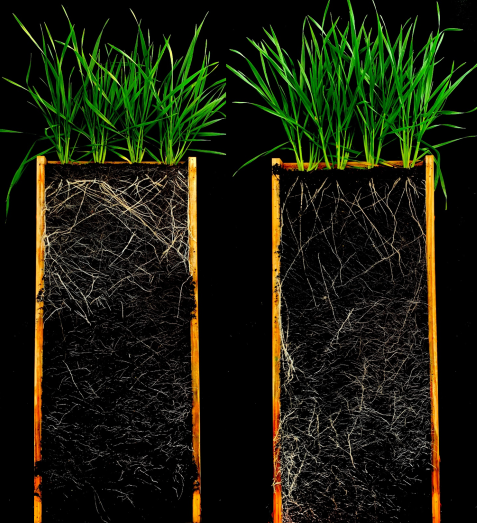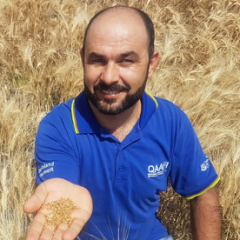To help meet strong international demand for Australia’s premium durum wheat, new research has identified genetic solutions to maintain yields during drought.
Queensland research has identified two genes that improve durum wheat yields under drought conditions. The research focusses on the architecture of plant roots and how it contributes to yield stability.
Dr Samir Alahmad, at the Queensland Alliance for Agriculture and Food Innovation (QAAFI) has discovered the genes while investigating the traits that durum wheat uses to survive in water-limited conditions.
Dr Alahmad is a previous recipient of Monsanto’s Beachell-Borlaug International Scholarship. His current research is part of a postdoctoral fellowship funded by the Grains Research and Development Corporation.
“In dry seasons like 2018 and 2019, farmers suffered significant losses due to reduced grain quality and yield,” Dr Alahmad says.
Stabilising yields and quality for the crop in a variable climate is an ongoing challenge for growers, while maintaining supply to international markets. More than 80 per cent of Australian durum wheat exports go to Italy, where it is used for pasta production.
The first step in Dr Alahmad’s research was establishing links with durum breeder Dr Filippo Bassi at the International Center for Agricultural Research in Dry Areas (ICARDA) to source elite durum lines that were originally bred for very dry conditions in Syria.
Collaborating with Professor Jason Able at the University of Adelaide, Dr Alahmad then crossed the ICARDA lines with the leading Australian durum wheats DBA Aurora and Jandaroi, subsequently developing a large experimental population to study their traits.
“You need six generations to develop genetically stable lines that are suitable for evaluation,” Dr Alahmad says. “I used speed breeding technology, which involves growing plants under optimal light and temperature conditions, to reduce generation time, and refined the population in just one year.”
The next step was to study the durum wheat population for root growth angle using transparent garden pots.
Dr Alahmad matched this information with DNA marker data to perform a genome-wide association analysis. The result was the discovery of a major gene located on chromosome 6A in durum wheat.
Over the following two seasons he set up field trials in Queensland, South Australia and Morocco to better understand the value of the gene in improving yields under different drought conditions.
“We found there was an association between the root angle gene and grain yield,” he says. “In Queensland, root angle appeared to be important for maximising the length of the grain-filling period.”

In another genome-wide association analysis, the location of the gene responsible for high-root biomass was identified on chromosome 6B.
“One of the most exciting aspects of the research was discovering that combining the root angle and root biomass qualitative trait loci resulted in a yield benefit of up to 0.9 tonnes per hectare under drought conditions,” he says.
However, more insight is needed to determine how much root branching is beneficial at different soil depths to sustain grain yields in different environments. Another challenge is understanding the complex interactions between root and canopy traits that influence the timing of water use.
Now, Dr Alahmad’s postdoctoral research is focused on developing elite durum wheat lines with similar above-ground traits that comprise different root configurations.
“These materials will enable us to more precisely determine the role of root traits to support yield under different drought scenarios.”
During 2020, seed of the elite lines with diverse root traits was bulked up at Hermitage Research Station, Warwick, Queensland. In 2021, field trials will be set up in Queensland and South Australia.
To take the research to the next level, Dr Alahmad is using unmanned aerial vehicles (UAV) to look at the effect of above-ground traits on drought tolerance.
“We will use this knowledge about the above-ground traits to better understand the value of root traits and the link between root and shoot dynamics,” he says.
“We want to help wheat breeders design future crops for farmers that provide more stable yields across seasons despite variable rainfall.
“In the next 12 months we will try to understand the traits that sustain grain yield in different seasons.”
This research is funded by the Grains Research and Development Corporation, Queensland Department of Agriculture and Fisheries and The University of Queensland.
Dr Samir Alahmad is an early career plant breeder and geneticist. His main interest is dissecting the genetics of complex traits that contribute to enhanced yield under drought and disease stresses. His research is focused on better understanding the genetics of drought adaptive traits such as root system architecture and canopy development. He is currently working on two GRDC funded projects that aim to develop elite bread and durum wheat varieties with optimal root system architecture for yield improvement.
Research contacts: Dr Samir Alahmad, Postdoctoral Research Fellow, QAAFI, Centre for Crop Science, s.alahmad@uq.edu.au, M: +61 405 946 915
Associate Professor Lee Hickey, Principal Research Fellow, QAAFI, Centre for Crop Science, l.hickey@uq.edu.au, T: +61 7 336 54805, M: +61 408 210 286
Media: Photos and video files for media use.
Source: Originally published in GRDC's GroundCover Issue 151, March-April 2021, Written by Nicole Baxter, Published online 30 January 2021. View online.
The Queensland Alliance for Agriculture and Food Innovation is a research institute at The University of Queensland, established with and supported by the Queensland Department of Primary Industries.




